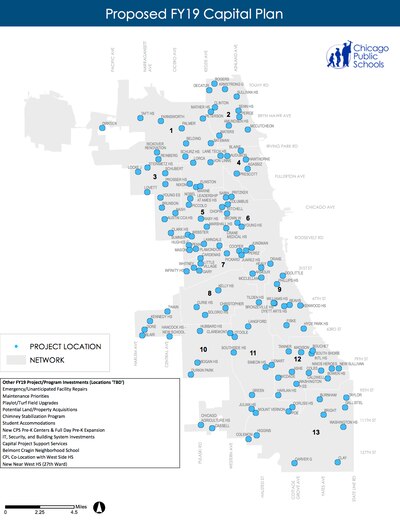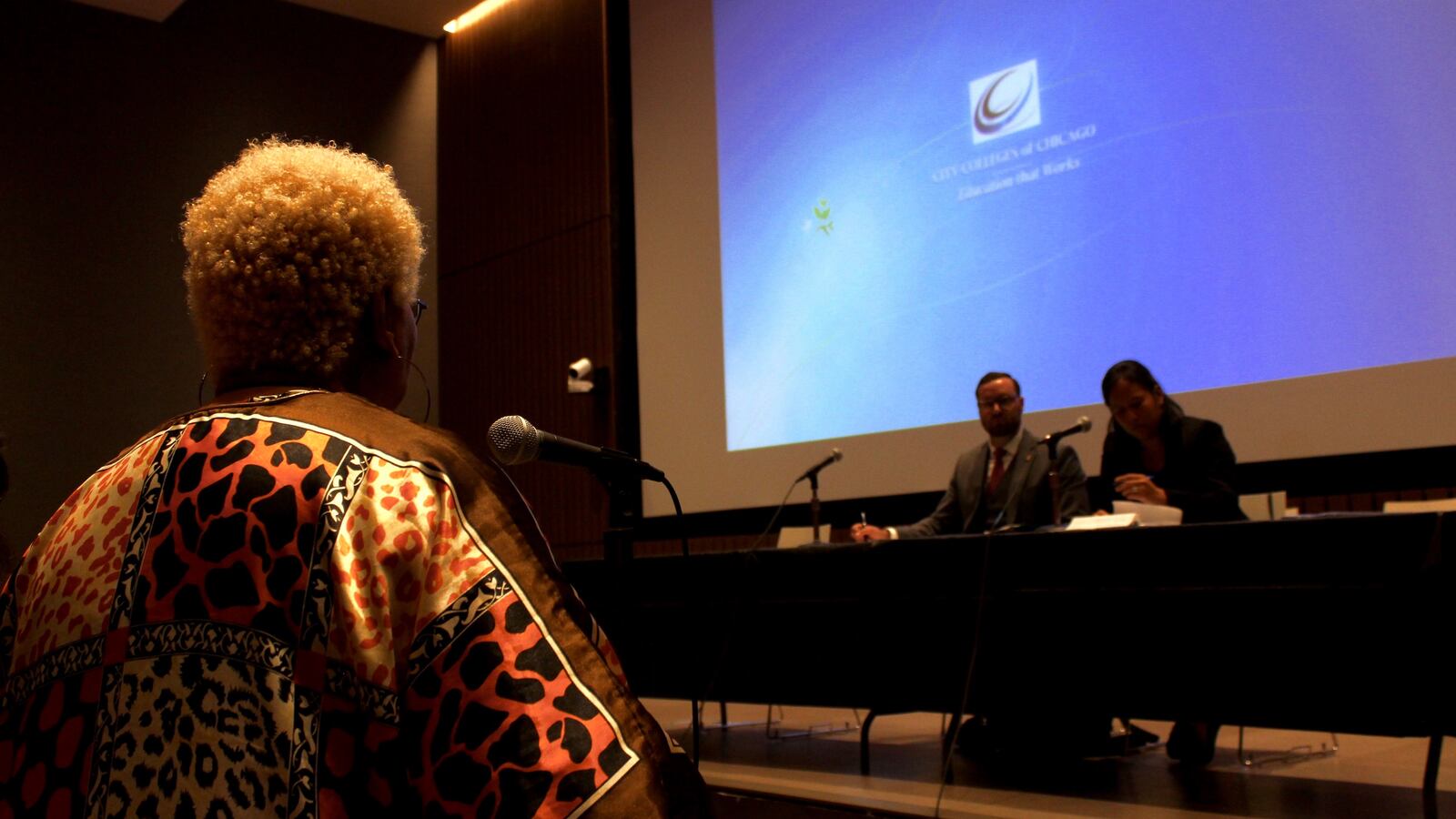Chicago Public Schools surprised many when it dropped its biggest facility spending plan a few weeks ago with a big “B”—that stands for billion—in the headline.
Considering that the district had planned to spend less than $200 million on capital needs for the 2018-2019 school year, this plan represents a five-fold increase. It relies largely on bonds to pay for building improvements and introduces new schools amid steadily shrinking enrollment, mostly in areas around gentrifying neighborhoods.
Divergent opinions surrounding the capital budget emerged at three concurrent community meetings CPS held Thursday night at City Colleges sites around Chicago: Malcolm X, Harry S. Truman, and Kennedy-King. The Chicago Board of Education is scheduled to vote on the district’s $7.58 billion budget, including the capital plan, on July 25.

At the Malcolm X meeting, CPS Senior Policy Advisor Cameron Mock presented a map showing capital budget projects distributed evenly throughout the city, but, as CPS Chief Financial Officer Jennie Bennett acknowledged, “not all projects are equal.”
Bennett explained that “the allocation of these projects were really in large part due to feedback about need.”
Chalkbeat mapped out the costliest capital projects, and found that the West side, particularly the Southwest side, received the smallest concentration of large investments.

At Thursday’s hearings, parents from schools that did receive significant funding, such as Christopher Elementary School in Gage Park and Hancock High School in West Elsdon, expressed thanks. But others asked for for more investment.
Residents questioned the plan to build a new $70 million high school on the Near West Side. Lori Edwards, a Local School Council member at Crane Medical Prep on the Near West Side, said that Crane desperately needed air conditioning and heating, doors with windows, and security cameras.
“I’m surprised that we can’t just get basic things instead of building a new high school,” she said.
Questions also surrounded the $44 million assigned for a new elementary school in Belmont Cragin on the Northwest Side to address overcrowding. A sophomore at Prosser High School in Belmont Cragin asked for investment in her school instead. At Prosser, she said, “there needs to be reconstruction in the classrooms, the paint on the walls is falling off.”
Leticia Neri, a mother of two students at Camras Elementary School in Belmont Cragin, was wary of adding a school to the neighborhood. Her children used to attend Burbank Elementary, which is also in Belmont Cragin. When Acero Roberto Clemente, a charter school, opened just two blocks down in 2013, she said that Burbank lost pupils.
However, Mock said the proposed new school was a response to demand in Belmont Cragin. And in fact, several miles north in Uptown, where CPS’s Chief Operating Officer Arnie Rivera and other officials led a meeting Thursday, a handful of Belmont Cragin residents argued in favor of the school.
Parent Mariela Estrada said Belmont Cragin Elementary, which her 9-year-old attends, is overcrowded. While the district’s formula doesn’t label any Belmont Cragin school overcrowded, the numbers paint a different picture. Belmont Cragin Elementary’s 414 students share a building with Northwest Middle School’s 545 pupils.
“I am really, really grateful right now for what we are getting,” she said.
The North Side, as the map above shows, will receive the most capital funding. Several attendees expressed gratitude for investments in area schools, especially a new ADA compliant gym at McCutcheon Elementary in Uptown, and an expanded test-in Decatur Classical School program in West Ridge, that will add seventh and eighth grades. Students have to test into the city’s five highly competitive classical schools, and hundreds are turned away every year.
Even so, not all North Side residents felt their schools would receive what they need, and many questioned CPS’ process for planning improvements.
A mother of a student at Schurz High School, in Old Irving Park, thanked CPS for a plans to install a new athletic field, but mentioned the school’s leaky roof, faulty heating system, green and black mold under carpets, and peeling paint in the auditorium. “It’s gross,” she said.
Parent Dawne Moon, said Kilmer Elementary School in Rogers Park is “not currently a safe environment.” Moon, a Local School Council member, complained of rusted lockers, “bathrooms that smell like urine, even after they are cleaned,” temporary covers over holes in the roof that keeps water from pouring into classrooms, and of bricks falling from the ceiling in the school’s gym.
“We can hope that the next brick doesn’t fall on a kid,” she said.
Betsy Vandercook, co-chair of the education committee at Network 49, a progressive neighborhood group based in Rogers Park, said schools in her neighborhood would get less than what adjacent communities like Edgewater and West Rogers Park would receive.
“Rogers Park is not, for whatever reason getting the same resources that many other North Side communities are getting,” she said about the capital budget proposal. “Take this back, look at it again, look at what is and isn’t needed.”

